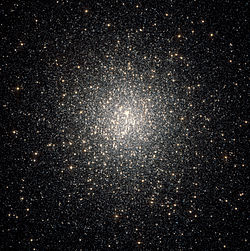astro.wikisort.org - Galaxy
NGC 2808 is a globular cluster[6] in the constellation Carina. The cluster belongs to the Milky Way, and is one of our home galaxy's most massive clusters, containing more than a million stars. It is estimated to be 12.5-billion years old.
| NGC 2808 | |
|---|---|
 A Hubble Space Telescope (HST) image of NGC 2808 | |
| Observation data (J2000 epoch) | |
| Class | I[1] |
| Constellation | Carina |
| Right ascension | 09h 12m 03.10s[2] |
| Declination | –64° 51′ 48.6″[2] |
| Distance | 31.3 kly (9.6 kpc)[3] |
| Apparent magnitude (V) | 6.2[4] |
| Apparent dimensions (V) | 13′.8[4] |
| Physical characteristics | |
| Mass | 1.42×106[3] M☉ |
| Metallicity | = –1.14[3] dex |
| Estimated age | 10.2 Gyr[5] |
| Other designations | GCl 13, Melotte 95[6] |
The cluster is being disrupted by the galactic tide, trailing a long tidal tail.[7]
Star generations
It had been thought that NGC 2808, like typical globular clusters, contains only one generation of stars formed simultaneously from the same material. In 2007, a team of astronomers led by Giampaolo Piotto of the University of Padua in Italy investigated Hubble Space Telescope images of NGC 2808 taken in 2005 and 2006 with Hubble's Advanced Camera for Surveys. Unexpectedly, they found that this cluster is composed of three generations of stars, all born within 200 million years of the formation of the cluster.[8]
Astronomers have argued that globular clusters can produce only one generation of stars, because the radiation from first generation stars would drive the residual gas not consumed in the first star generation phase out of the cluster. However, the great mass of a cluster such as NGC 2808 may suffice to gravitationally counteract the loss of gaseous matter. Thus, a second and a third generation of stars may form.
An alternative explanation for the three star generations of NGC 2808 is that it may actually be the remnant core of a dwarf galaxy that collided with the Milky Way, the Sausage Galaxy.[9]
See also
- Messier 54 and Messier 79, two other extragalactic globular clusters
- Omega Centauri
References
- Shapley, Harlow; Sawyer, Helen B. (August 1927), "A Classification of Globular Clusters", Harvard College Observatory Bulletin, 849 (849): 11–14, Bibcode:1927BHarO.849...11S
- Goldsbury, Ryan; et al. (December 2010), "The ACS Survey of Galactic Globular Clusters. X. New Determinations of Centers for 65 Clusters", The Astronomical Journal, 140 (6): 1830–1837, arXiv:1008.2755, Bibcode:2010AJ....140.1830G, doi:10.1088/0004-6256/140/6/1830, S2CID 119183070.
- Boyles, J.; et al. (November 2011), "Young Radio Pulsars in Galactic Globular Clusters", The Astrophysical Journal, 742 (1): 51, arXiv:1108.4402, Bibcode:2011ApJ...742...51B, doi:10.1088/0004-637X/742/1/51, S2CID 118649860
- "Data for NGC 2808". NGC/IC Project. Archived from the original on 15 January 2013. Retrieved 19 November 2013.
- Koleva, M.; et al. (April 2008), "Spectroscopic ages and metallicities of stellar populations: validation of full spectrum fitting", Monthly Notices of the Royal Astronomical Society, 385 (4): 1998–2010, arXiv:0801.0871, Bibcode:2008MNRAS.385.1998K, doi:10.1111/j.1365-2966.2008.12908.x, S2CID 17571531
- "NGC 2808". SIMBAD. Centre de données astronomiques de Strasbourg. Retrieved 2007-05-07.
- Carballo-Bello, Julio A.; Martínez-Delgado, David; Navarrete, Camila; Catelan, Márcio; Muñoz, Ricardo R.; Antoja, Teresa; Sollima, Antonio (2017), "Tails and streams around the Galactic globular clusters NGC 1851, NGC 1904, NGC 2298 and NGC 2808", Monthly Notices of the Royal Astronomical Society, 474: 683–695, arXiv:1710.08927, doi:10.1093/mnras/stx2767
- Piotto, G.; et al. (May 2007). "A Triple Main Sequence in the Globular Cluster NGC 2808". The Astrophysical Journal. 661 (1): L53–L56. arXiv:astro-ph/0703767. Bibcode:2007ApJ...661L..53P. doi:10.1086/518503. S2CID 18691514.
- C., Myeong, G.; W., Evans, N.; V., Belokurov; L., Sanders, J.; E., Koposov, S. (2018). "The Sausage Globular Clusters". The Astrophysical Journal. 863 (2): L28. arXiv:1805.00453. Bibcode:2018ApJ...863L..28M. doi:10.3847/2041-8213/aad7f7. S2CID 67791285.
External links
 Media related to NGC 2808 at Wikimedia Commons
Media related to NGC 2808 at Wikimedia Commons
На других языках
[de] NGC 2808
NGC 2808 ist die Bezeichnung eines Kugelsternhaufens im Sternbild Carina. NGC 2808 hat eine scheinbare Helligkeit von 6,9 mag und einen Durchmesser von 13,8 Bogenminuten. Dieser Haufen ist einer der wenigen Kugelsternhaufen am Winterhimmel, ist allerdings nur von sehr südlichen Breiten sichtbar. Die Lage dieses Kugelsternhaufens am Winterhimmel erhielt zusätzliche Brisanz durch die Entdeckung der Canis-Major-Zwerggalaxie im Jahre 2003. Genau wie Messier 79 und NGC 1851 scheint dieser Sternhaufen nicht zufällig in dieser Region des Himmels zu liegen, die ansonsten arm an solchen Objekten ist, denn er scheint seinen Ursprung nicht im Milchstraßensystem zu haben, sondern wurde zusammen mit jener Zwerggalaxie eingefangen.- [en] NGC 2808
[es] NGC 2808
NGC 2808 es un cúmulo globular en la constelación austral de Carina. Se encuentra a medio camino entre Aspidiske (ι Carinae) y Miaplacidus (β Carinae). De magnitud aparente 6,2, es un cúmulo muy compacto (clase I). Se encuentra a 31.200 años luz de la Tierra y a 36.200 años luz del centro galáctico. Fue descubierto por James Dunlop en 1826.[ru] NGC 2808
NGC 2808 (другие обозначения — GCL 13, ESO 91-SC1) — шаровое скопление в созвездии Киль. Одно из самых крупных объектов своего класса[3]. При помощи телескопа «Хаббл» в созвездии было обнаружено несколько поколений звёзд. Ранее считалось, что «звёзды в сферических скоплениях образуются в одно время, в одном месте и из одного материала, после чего развиваются на протяжении всего существования скопления»[3].Другой контент может иметь иную лицензию. Перед использованием материалов сайта WikiSort.org внимательно изучите правила лицензирования конкретных элементов наполнения сайта.
WikiSort.org - проект по пересортировке и дополнению контента Википедии
